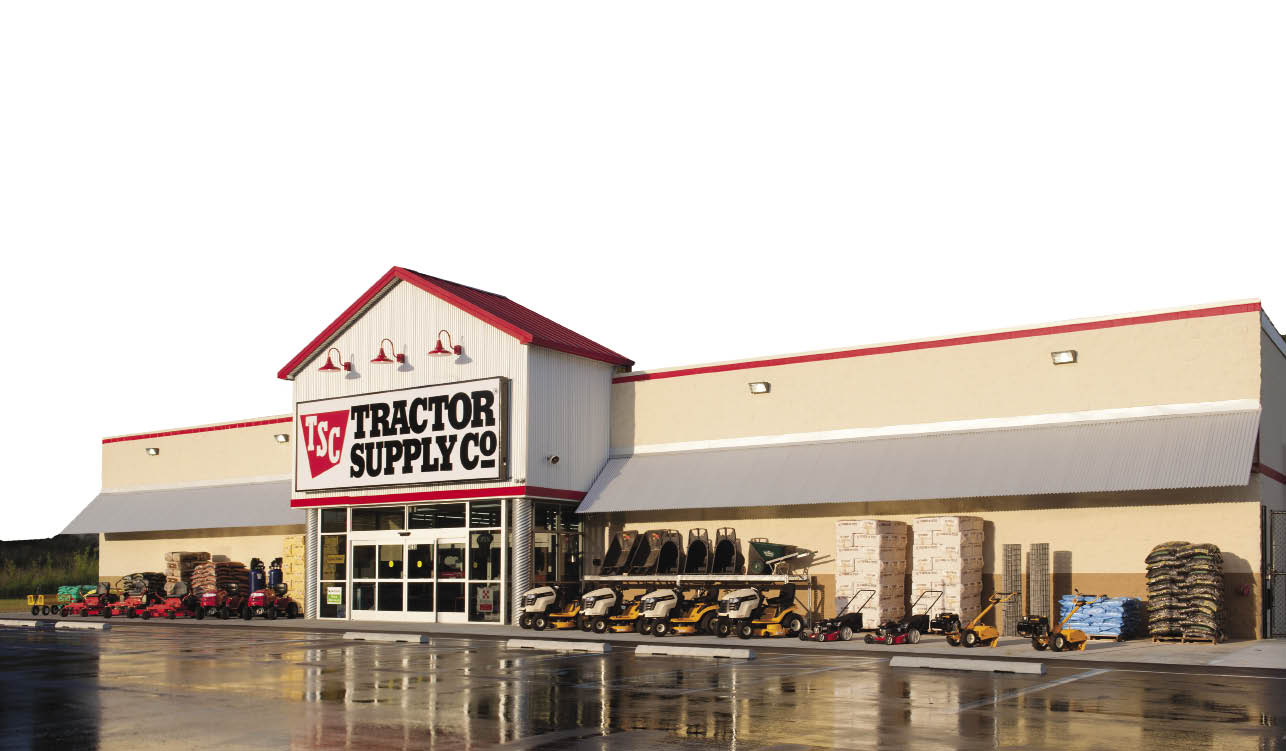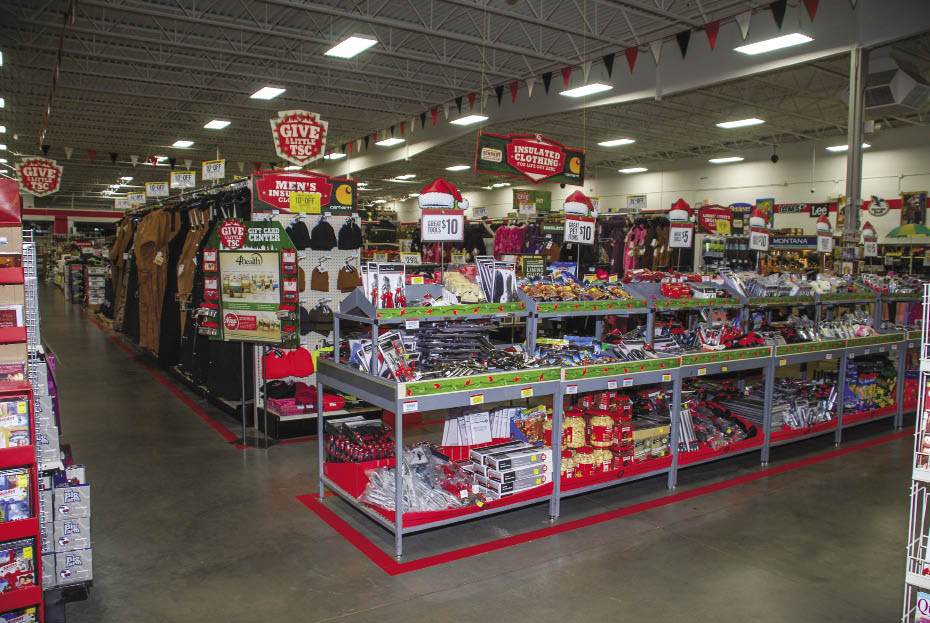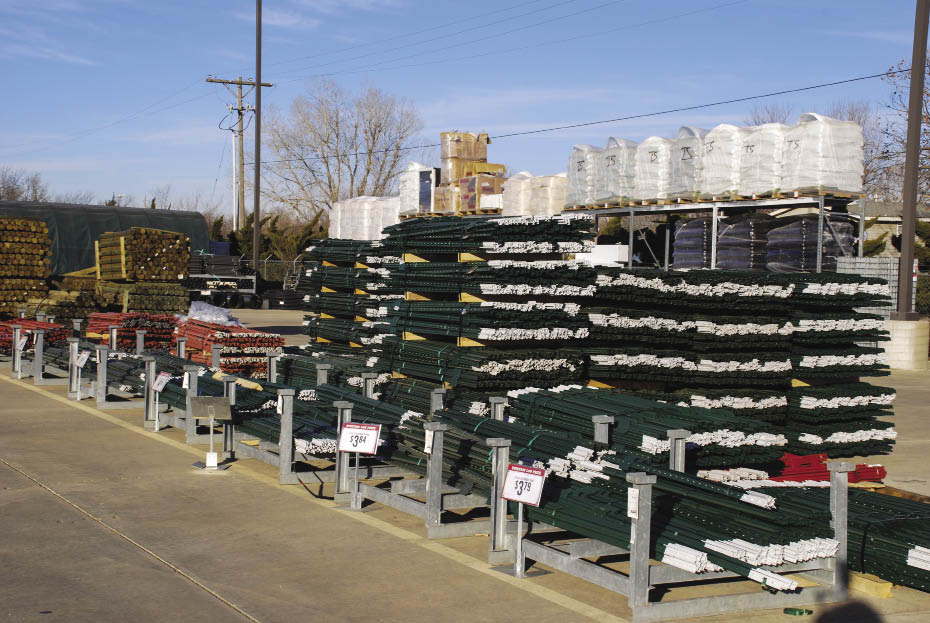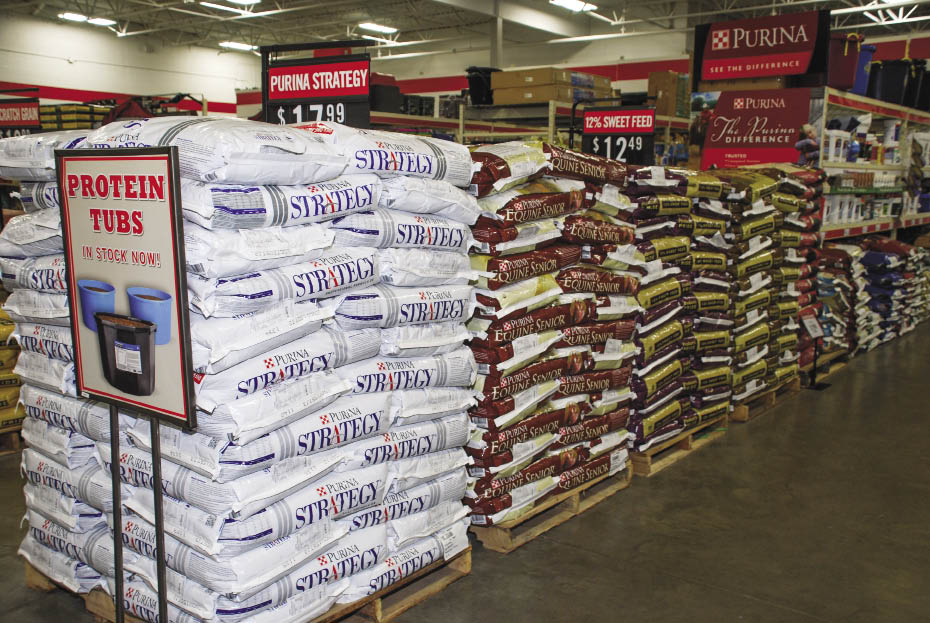Last year, rural lifestylers spent billions of dollars at Tractor Supply’s 1,151 stores in 45 states. In 2013, the company expects to open 90-100 more stores, as they head west into new markets. What does Tractor Supply offer — and do — that wins over rural lifestylers?
“When we go into a market we’re not the first person selling feed, tack, dog food, hardware products or fencing products, but at Tractor Supply we have all that under one roof, at one location. We’re a one-stop shop. We’re priced right. We’ll have the inventory and depth that you need and you can make one trip to our store,” says Greg Sandfort, Tractor Supply’s president and chief executive officer.
Or, the company describes the approach this way: The right stuff, in the right place, at the right time.
Sandfort, who took over CEO duties in December, shares Tractor Supply’s approach to merchandising, customer service and the importance of a knowledgeable store team in this exclusive interview. The strategies, which led to sales of $4.2 billion in 2011 and profits of $222 million, can offer dealers new ways to lead in their own markets.
Know Your Customers
Having the right stuff means understanding your customers. Sandfort says market research shows its core demographics have remained constant.

Tractor Supply has more than 1,150 stores in 45 states. In 2013, the company plans to open 90-100 new stores and expand into the western United States.
Tractor Supply Defined

Founded: 1938 as a mail order tractor parts company. First retail store opened in 1939 in Minot, N.D.
Company Overview: Headquartered in Brentwood, Tenn. Stock is traded on the NASDAQ exchange under the symbol TSCO. Company employs more than 17,000 people.
Stores Today: 1,151 stores in 45 states
Brands: Carhartt, Campbell Hausfeld, Cub Cadet, DeWalt, Justin, Pedigree, Purina, Science Diet and Wolverine. Exclusive brands include 4health, Dumor, GroundWork and JobSmart.
“The common bond that we have across all our customer base is that our customers own land, they own animals, they have machinery and they probably own a pickup truck,” he says. “They’re self-sufficient, so we try to help them understand the project when they come into the store and work with them to make sure they have all the materials necessary to complete that project.”
The typical age group is 45-60 — and they are fiscally conservative.
“They don’t have massive homes with no furniture inside. They live conservatively,” Sandfort says.
That conservative nature applies to how they pay, too. Very few purchases made at Tractor Supply are made by credit. In fact, Sandfort says one customer gave him this reason for why he was delaying purchase of a $5,000 riding mower.
“He says, ‘Here’s the problem. I don’t have the money to buy it today, so I guess I just don’t need it right now do I?’ ”
Tractor Supply kept that attitude in mind during the recent recession and caters to that attitude today.
“During the recession in 2008, for instance, we intensified our focus on consumable, usable and edible products, or what we call C.U.E. products. These are non-discretionary products that our customers use in their daily lives and rely on, such as animal and pet feed, repair and replacement parts and other fast-turning products. We made sure that our in-stock positions on those items were at an all-time high and we had a very large commitment to making sure our customers were never disappointed when they visited our stores,” Sandfort says. “That has paid off well for the company. It repositioned us to be the most dependable supplier, which is part of our mission and values.”
This practice goes against traditional retail thinking where retailers often reduce inventory during difficult economic times. Tractor Supply’s every-day, value pricing reinforces that customers can depend on the company and sets it apart from the competition.
“Those who we compete with run ads every week. What’s the difference? The difference is we’re priced right every day. We’re not playing the ‘mark it up high’ and then run a sale every week and bring the price down,” he says.
Dealer Takeaways
• Sell what your customers need. Uncover sales opportunities by learning demographics, such as income, acreage, and animals and equipment already owned.
• Be willing to test new products to give customers a reason to come back and see what’s new.
• Establish a pricing structure that your customers trust. Don’t say something is on sale, when it’s really not.
• Don’t underestimate the influence that an employee can have on equipment sales. Hire knowledgeable employees who understand the rural lifestyle.
Tractor Supply only runs ad campaigns about 15 times a year, so he says customers know sale prices are real when they see an ad.
Keep Merchandise Targeted, Fresh
Tractor Supply offers the following general categories of products:
1. Equine, pet and small animal products, including items necessary for their health, care, growth and containment
2. Hardware, truck, towing and tool products
3. Seasonal products, including lawn and garden items, power equipment, gifts and toys
4. Maintenance products for agricultural and rural use
5. Work and recreational clothing and footwear.
But it’s the combination of products to fit regions — more than 600 variations — that makes Tractor Supply a retail powerhouse.
“It’s critically important for us as a company to be relevant in the markets that we serve. That’s a true point of differentiation between us and possibly some other retailers who have categories of products, but not an entire store like ours.”

A merchandising strategy is the “center court” area. It showcases seasonal products and encourages purchases beyond what was on the customer’s shopping list.
For example, Tractor Supply recently expanded into Colorado. They learned that offering hay would be important for reaching animal owners, so Colorado stores have hay barns and drive-through feed operations.
“We look for those gaps where we can bring something to the market that others can’t,” he says. Other stores may only be able to sell bagged feed.
For both new stores and long-established stores, the other critical merchandising element is “fresh.” Sandfort draws on his experience with another retail giant, Michaels, the arts and crafts store, and things he learned when he served as Tractor Supply’s chief merchandising officer. The key is to view the stores as a customer would and arrange product displays to make browsing and buying easier.
From Candy to Air Filters: Helping Shoppers in Hutchinson, Kan.
“Can I help you find something?” rings out over and over in the Tractor Supply store in Hutchinson, Kan. One customer says “yes,” as she was on the hunt for circus peanut candy. (“Grandma loves them.”) Another says, “I know my way around,” as he made his way to the air filters and then back up to the cash register.
Ken Engle, store manager, says he wants customers to be greeted by every team member they meet.
“We want to be sure to create the customer experience they deserve,” he says.
Employees like Susie Denny make sure that happens. Denny has been working at Tractor Supply for 20 years and is quick to smile and say hello as customers walk past her register.
Denny is the kind of team member that helps Tractor Supply win customers because she’s a customer herself. She purchases products for her rural lifestyle and merchandise for grandchildren.
“If Tractor Supply sold groceries and fuel I wouldn’t have to shop anywhere else,” she says.
“I was standing in front of the store one day and I said, ‘We’ve got a problem here. We’re walking people to death. They’re never going to go to the right or left side because they can’t get there easily.’ So, we started to carve aisle space and make it easier for customers to cross back and forth. That was simple, but we didn’t see this concept before,” he says.
Sandfort describes Tractor Supply customers as “destination shoppers,” in that they travel to different parts of the store for unrelated items. The stores’ newly designed layouts lead shoppers from one side to the other, while encouraging stops throughout the store. For instance, the “center court” area, which sits directly behind the check-out counters, rotates seasonal products. He says customers may not have come into the store looking for these products, but the placement and value pricing convinces them to purchase.
The “endcaps,” or product displays at the end of an aisle, show off promotions. These areas generally display similar items. For example, the products might be one item or multiple items at one price or related items, such as bird feeding products. The products in the endcaps are changed about every 90 days.
New signage also helps direct customers to departments. Rural images on the signs add to the stores’ country feel.
“We’re getting rave reviews from customers. They’re saying, ‘Wow, you must have remodeled the store,’ ” Sandfort says, when all they did was change and improve the signage.
Hire Team Members Who Live the Rural Life
In addition to the science behind shopping, Sandfort says the Tractor Supply difference is the store teams.
“We hire our customers. They live the rural lifestyle,” he says. “We hire hard and manage easy.”


Tractor Supply focuses on having a full inventory of consumable, usable and edible products, such as animal and pet feed, repair and replacement parts and other fast-turning products, at value prices every day. The company wants to be a “one-stop shop.”
Sandfort describes a screening process, in which 100 applicants might be narrowed down to 15 or 20. From there, they hire for attitude, a willingness to engage with the customer and knowledge of rural life, animals, tools and related topics. Training helps educate new team members on the Tractor Supply mission: “To work hard, have fun and make money by providing legendary service and great products at everyday low prices.”
To make that mission a reality, team members follow the GURA philosophy, which stands for “greet (the customer), uncover (their needs), recommend (products) and ask (for the sale).”
“I compare Tractor Supply to other stores, where employees have their heads down doing their work and ignoring customers. Our team members drop what they are doing and help you get in and out quickly.”
This interactive, GURA-based approach is especially important when selling more expensive items, like riding mowers.
“We’re first going to try to use that GURA method: greet you, let you know we’re glad you’re here, try to understand your needs. If you only need a 36-inch-cut mower because you don’t have that much property to take care of, we’re not going to try to sell you a 60-inch cut. We’re going to say, ‘Listen, you really only need this size mower and this size horsepower and you can save yourself $1,500.’ ”
Ongoing Research, Evaluation Uncovers Opportunities
Tractor Supply has a formula that works, but the company makes sure that continues to be true through these efforts:
1. Market research
2. Customer surveys
3. Product testing
Store Support Programs Make Tractor Supply Mission a Reality
It is Lee Downing’s job to make sure each Tractor Supply store carries out this mission: “To work hard, have fun and make money by providing legendary service and great products at everyday low prices.”
Downing is Tractor Supply’s senior vice president of store operations and oversees more than 1,100 stores. He says the mission comes to life through the company’s “GURA” method of customer service, which stands for “greet, uncover, recommend and ask.”
“We want to meet our customers’ needs, have them talk with knowledgeable team members and fulfill the projects they wanted to do that day,” says Downing. “GURA has become a rallying point for the store teams in building relationships with customers.
“Other stores may welcome you, but that’s where it stops.”
Training programs keep GURA top of mind. For instance, each month Downing may ask store teams to use the approach on certain items. A quarterly newsletter includes GURA success stories and customer testimonials are posted in break rooms.
Supporting Retail Experience
It takes more than friendly team members to drive purchases. Tractor Supply’s retail layout encourages shoppers to move around the store. A “center court” area behind the cash registers has seasonal merchandise. Core products, such as feed and parts, line the outside of the store. Smaller items related to each product category are displayed at the end of the aisles, called “endcaps.” For example, dog bowls and treats might be displayed near the dog food aisle.
The merchandising presentation team builds the displays at the Store Support Center (company headquarters). They send photos and directions and daily and weekly product updates.
“We’re a very hands-on organization. We want to make sure the store teams feel comfortable and give them the best possible direction,” Downing says.
Finding the Fun in Customer Service
Downing shares this personal story about what it means to serve the customer and still have fun. Part of his own training was to work in a store and he was given the task of loading up 30 cattle panels for a customer. The customer did inspections along the way, only choosing about every other one from a stack. Downing says he moved about 100 cattle panels to finally get the 30 the customer wanted.
“When I finished the whole team was at the front of the store cheering and laughing. I was part of the team and having a good time while getting the sale,” Downing says.
“It’s about doing whatever it takes to make sure the customer leaves happy and comes back,” he says.
When considering a new location, the company’s merchant team, which sometimes includes Sandfort, does extensive on-site research. They interview residents in person and seek them out online to see what products and equipment are used in the area. They also look at the existing competition, including independently owned operations. Sandfort says those independent stores may be doing a great job. However, it goes back to the strength of the one-stop shopping experience.
“If I can save you time — give you back time to do other things — make it easier for you and give you great service, chances are you’re going to probably shop with me again and again and again,” he says.
The stores also continue to test products to ensure they are meeting needs and uncovering new sales opportunities.
“We know our customers are looking for the latest and the greatest. Even though they buy the same staples over and over, if there’s something new in equine, they’re going to look for us to be the leader and to have it,” Sandfort says.
He says this approach offers a kind of treasure hunt, where customers are encouraged to seek out the newest innovations.
“That is something you don’t find in too many of our competitors out there. They do the same thing over and over. There’s nothing wrong with that, but our belief is that you have to keep bringing newness to the retail environment. It gives them a reason to come back,” he says.
That return trip is also not taken for granted. The company’s customer relationship marketing system tracks buying patterns based on each purchase, which can lead to direct marketing opportunities.
For instance, they know from their research that 99% of those who own horses also own dogs. For those horse owners who aren’t already purchasing pet food, the company may send direct mail with a dog food coupon.
And, Tractor Supply asks for direct input. Purchase receipts may list a toll-free number for a satisfaction survey. One incentive: a $2,500 gift card.
What Tractor Supply Isn’t
Tractor Supply also knows the kind of store it doesn’t want to be.
“We are not in the production farming business,” Sandfort says.
He says the equipment they carry is purposely limited. However, it’s varied enough to support small-scale farming in different parts of the U.S. What about for the long-term?
“We’re not going to get into any larger equipment. That’s not who our customer is. I can’t compete with John Deere dealers and those kinds of stores. And, honestly, we’ve had very few requests for any larger equipment.”
Sandfort says they also don’t plan to expand into the service business, with store space and service expertise as limiting factors.
“I don’t think that we would be very good at trying to set up our own service business within each store. It’s a piece of business we’ve opted not to pursue, and unfortunately that does keep us from carrying a few brands out there in the marketplace,” he says.
They do offer customers referrals for service within each region, though.
What’s Ahead?
Sandfort says the rural lifestyle market continues to grow, especially in what he refers to as the first and second band of counties outside major metropolitan areas. He says this market hasn’t been affected by certain economic factors because rural lifestylers tend to own their properties or have small mortgages. Also, he believes job losses were curtailed faster in rural areas.
Sandfort does think the overall economic status of the U.S. has a psychological impact on purchases. Tractor Supply customers will stay committed to living their rural lifestyle, but remain conservative on purchases. He calls it the “new normal.”
That means the company will continue to be a one-stop shop for consumable, usable or edible products at value prices.
They are also targeting more urban customers who need these products. They recently tested television advertising, with team members explaining that the store is about more than farm supplies.
For all customers, Tractor Supply is building its presence as a multi-channel retailer. For instance, a revised website is expected to be launched by midyear, where customers can purchase many more items than today. He says the site will never replace its stores, but they do want to build their online community.
“The four-wall store is very important. There’s intimacy between our customers and our team members. They trust one another. They like to have those conversations where they come in to talk about projects and their animals.”
He says the site can combine shopping experiences. For instance, a customer may browse online and purchase in the store or purchase online and pick the item up in the store.
They also plan to enhance the company’s Facebook presence by encouraging customers with similar interests to comment and share.
Sandfort says customer service will remain top of mind, whenever and wherever customers find them.
“Our job is to take care of them. We don’t see a lot of change in that. They’re wonderful customers to have,” Sandfort says.





Post a comment
Report Abusive Comment